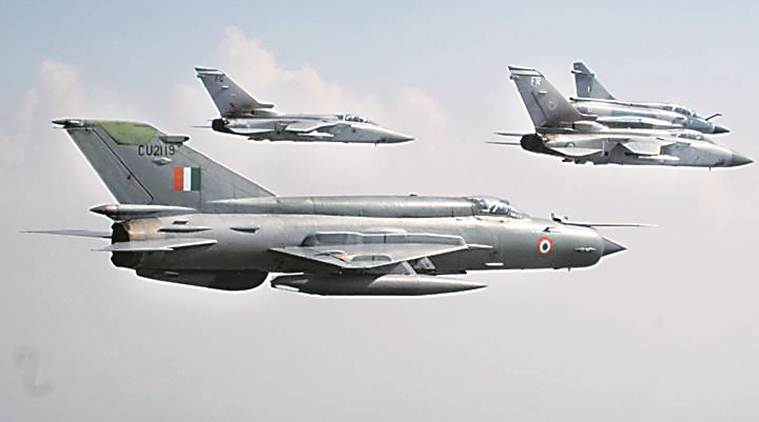History Headline: That September near Sialkot
The successful strike at Balakot on a dark night by a group of combat aircraft was the very first pre-emptive strike ordered by the government since Independence.

The shooting down of a Pakistani F-16 by Wing Commander Abhinandan with his MIG-21 — the first-ever Indian pilot to do so — is of historical significance. It also marks the first MIG-21 kill of the legendary F-16 in the world, and ushers in a new era of air warriors snapping the umbilical cord tying them to old traditions and constraints regarding aerial combat. This coincides with the Indian Air Force attaining maturity through global exposure, improved infrastructure, upgraded machines etc, as a result of friendly relationships with foreign air forces and exercising with them.
The successful strike at Balakot on a dark night by a group of combat aircraft was the very first pre-emptive strike ordered by the government since Independence. It went like clock-work, signifying the sophistication in planning and executing a complex mission. A knee-jerk reaction, supported by the belief of their invincibility and of their superior force, brought the Pakistani Air Force out the next morning. The IAF was fully prepared; they were welcomed by a sharp formation of Mig-21 Bisons.
This incident takes me back to 1965 when the IAF launched the very first offensive air sweep mission against Pakistan after Independence. It is interesting to note the changes and improvements in these 54 years.
Towards the end of August 1965, the IAF Vampire jets attacked advancing Pakistani tanks in the Akhnoor sector and engaged them for two days. On the third day, Pakistani F-86 jets pounced on the slower Vampire jets and shot down four, killing three pilots. After that loss, the IAF withdrew the Vampires and the faster and heavier Mystere-IVs were employed. Gnat fighters were India’s frontline air combat squadrons at the time. I had converted to the Gnat five months earlier. On September 1, eight pilots from Gnat Squadrons were chosen to head to Pathankot. On landing, we were taken to the briefing room. There was anticipation about what was to come. On the tarmac we were told that our task was to even out the score — to shoot down four enemy jets.
In the operations room there was a vertical glassboard with circles drawn and some rudimentary maps with borders marked. An elaborate briefing was held for four hours, but it was all mundane stuff. I felt 10 ft tall but had no idea how this would work out. We were told that our radars were not fully functional and to not depend on them for information on enemy aircraft. The base communication system was weak and we were to contact adjacent bases if we needed help.
Jammu airfield could not be used by the Gnats. The infrastructure for stay and meals was meagre. The next morning we were to go for a briefing at 4 am.
The next morning, eight Gnats in two groups of four took off at dawn and headed low towards Sialkot, following the foothills up to Jammu. We then climbed to 20,000 ft towards Sialkot. Our brief was simple: to fly deep into Pakistan. Once we were detected, the enemy F-86s would come to intercept us, we were to fight them and shoot them down! But, we had no radar cover and depended totally on eyeballs. We can’t imagine such a mission today. But there was a major difference: those days none of the fighters carried air-to-air missiles. Shooting was done with guns, for which the attacking aircraft had to come less than 800 metres near. Fighter pilots had to visually pick their targets for shooting down. Ground radars controlled and brought them closer to the target. These days all fighters carry air-to-air missiles that are launched typically between 2- to 10-km ranges.
We reached 20,000 ft and started patrolling near Sialkot. Very soon, we spotted the F-86s. The Gnat was a very small aircraft and difficult to spot. Combat ensued, we managed to shoot down one F-86 while the rest disappeared. On our way back, we had no help from our ground stations and radars. We headed in a general direction. One of our members was running short on fuel and, being unsure of his position, landed on an airfield. The airfield happened to be inside Pakistan. That was a nightmare.
Despite infrastructural challenges, what kept us going was the spirit of taking risks beyond the call of duty — that was the way of life for fighter pilots those days, a bit careless, but highly motivated to fly. Our quality of training depended on our commanding officers and flight commanders, and our keenness to learn.
The IAF has set up fine institutions over the last two decades. They now have excellent infrastructure and support systems, and modern electronic displays and automated systems in the operations room. Our Air Force routinely trains with Air Forces of Europe, the US, the UAE, Oman, Singapore and others. With aerial tanker support, our combat aircraft have flown all the way to Alaska, South Africa, Singapore and elsewhere. They now have proven capabilities that can match the large modern Air Forces of the world.
I am glad that the government has taken cognisance of the capability and decided to utilise their potential effectively.
The writer is a former IAF chief






































No hay comentarios:
Publicar un comentario